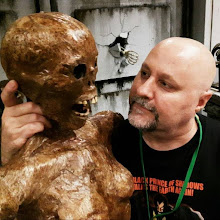 While researching literature for possible inclusion in The Great Fright North, I came across Lost House by Frances Shelley Wees, which was described as "an eerie mystery of the Canadian North" on the cover of Argosy (V.284 N.2, Aug. 27, 1938).
While researching literature for possible inclusion in The Great Fright North, I came across Lost House by Frances Shelley Wees, which was described as "an eerie mystery of the Canadian North" on the cover of Argosy (V.284 N.2, Aug. 27, 1938).
This was the first of six weekly issues of Argosy in which Wees's story was serialized, so I jumped the gun (as is my nature) and bought each of them, with the hope that the story was truly "eerie" enough to be included in my book. Unfortunately, I was wrong.
The story takes place in the Rocky Mountains of British Columbia--not what we consider the "Canadian North" nowadays--and actually opens in London, England at Scotland Yard, where an unnamed constable is tasked with infiltrating "Lost House," a remote Canadian resort home that a notorious criminal, nicknamed The Angel, is suspected of using as his base of operations. As the story goes, twenty-odd years ago, just outside the hamlet of Dark Forest, BC, a titled old Englishman built a stately mansion (which was an exact replica of his English house) near a silver mine that turned out to be a dud. He soon ran out of money, and as such, his family was forced to turn the great house into a summer hotel. The remote location was all but unknown to most Canadians, as the vacationers tended to come from the highest of British social circles. These included James Herrod Payne, a novelist; Shane Meredith, a famous tenor; and Lord Geoffrey Revel, who was pretty much famous for just being rich. Unbeknownst to the family, The Angel has taken up residence at the hotel, under an assumed name, and is using the secluded area for his own nefarious purposes.

As the story opens, a young doctor named David Aylesworth, on holiday from Edmonton, is exploring the area in search of the mysterious house when he stumbles upon a dead man at the edge of a river, who apparently fell to his death from the cliffs high above. A mystery ensues when David, an outsider, finds himself at Lost House in search of answers, where he meets the other occupants including a curmudgeonly doctor, his mysterious patient, and the overwrought matriarch of the family--as well as her daughter, who soon falls in love with the young doctor.
Although there are no supernatural happenings in the story, there are certainly a number of Gothic elements, after a fashion. And there are a few red herrings regarding the identity of The Angel that keeps one guessing till the end. I don't want to give away the story, but it primarily involves the illegal drug trade, and an unknown addictive substance that initially causes hysterical excitement, but ultimately leads to paralysis and then death. Wees's writing is quite entertaining, with some witty characters including Miss Lessington, who at one point tells David: "You don't talk to me in the least as if I were sixty. You've no idea how boring it is to be sixty . People think they have to discuss nothing more exciting than rheumatism."
Here are the covers of the six issues of
Argosy in which the story was serialized:
 |
| Argosy, Aug. 27 1938 |
|
 |
| Argosy, Sep. 3 1938 |
|
 |
| Argosy, Sep. 10 1938 |
|
 |
| Argosy, Sep. 17 1938 |
|
 |
| Argosy, Sep. 24 1938 |
|
 |
| Argosy, Oct. 1 1938 |
|
Lost House was also reprinted as a complete novel by Harlequin; initially in May, 1949 (#2), and again in April, 1954 (#295). As per the sales tactics of the day, the cover depicts a frightened young woman running away from a mysterious house, with a hypodermic needle superimposed over her for good measure--and a catchy cover blurb that reads: "Dope, Danger and Dolls."
Born in Oregon, Frances Shelley Wees spent most of her life in Canada even though she never surrendered her American citizenship. She moved to Saskatoon in her early teens, attended the University of Alberta, and eventually became a teacher. She wrote over two dozen romance and mystery novels, as well as numerous stories that were serialized in pulp magazines of the day. Her marriage to Wilfred Rusk Wees eventually took her to Toronto, and then to Stouffville, Ontario. They retired to Denman Island, BC, where she died in 1982.
Wees also wrote
The Mystery of the Creeping Man (1931)--perhaps I'll have better luck with that one!
 While researching literature for possible inclusion in The Great Fright North, I came across Lost House by Frances Shelley Wees, which was described as "an eerie mystery of the Canadian North" on the cover of Argosy (V.284 N.2, Aug. 27, 1938).
While researching literature for possible inclusion in The Great Fright North, I came across Lost House by Frances Shelley Wees, which was described as "an eerie mystery of the Canadian North" on the cover of Argosy (V.284 N.2, Aug. 27, 1938).














LOST HOUSE was originally published in 1938 by Hurst & Blackett in the UK and by McRae-Smith Company the same year in the US. I have a beautiful copy of the UK edition with the extremely rare original dust jacket which can be seen here.
ReplyDeleteThe Mystery of the Creeping Man is a detective novel. It contains nothing remotely supernatural. But there is a bizarre finale that takes place in a secret lab accessible only by underground passages where a truly mad scientist is conducting bizarre experiments. I also have a copy of that book and reviewed it on my blog here.
Thanks, JF, now I know I can check that one off of my list! Cheers.
ReplyDelete